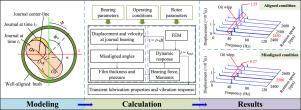考虑时变偏心的转子轴承系统的非线性动态行为
IF 7.1
1区 工程技术
Q1 ENGINEERING, MECHANICAL
International Journal of Mechanical Sciences
Pub Date : 2024-10-11
DOI:10.1016/j.ijmecsci.2024.109772
引用次数: 0
摘要
近年来,考虑到轴颈变形引起的不对中,对流体动力轴承支撑的旋转系统的动态响应进行了研究。然而,之前的大部分研究都是将不对中角作为固定配置进行研究,忽略了轴颈变形随时间变化引起的不对中变化。本研究提出了一种数值方法,用于预测转子轴承系统在考虑随时间变化的不对中情况下的动态响应。由于轴颈变形被认为是导致不对中的重要因素,因此考虑采用柔性转子来确定不对中状态。采用有限元法计算转子的动态变形,并据此计算错位角度和薄膜厚度。随后,使用有限差分法计算油膜的压力分布,以更新轴承力。根据数值计算结果,讨论了转子的瞬态润滑性能和振动响应。特别是比较了对准和错位条件下油鞭现象的差异。结果表明,考虑到轴颈挠度,轴颈方向随时间变化。对油鞭现象的讨论表明,不对中对系统的稳定性有重大影响。此外,瞬态润滑特性受转速和外部负载的影响很大,因为它们会影响共振振动和油鞭的大小。本文章由计算机程序翻译,如有差异,请以英文原文为准。

Nonlinear dynamic behavior of a rotor-bearing system considering time-varying misalignment
The dynamic response of rotating systems supported by hydrodynamic bearings considering the journal deformation-induced misalignment has been investigated in recent years. However, most of the previous work studied misaligned angles as fixed configurations, ignoring the variation of misalignment due to the time-varying journal deformation. In this study, a numerical method is proposed to predict the dynamic response of a rotor-bearing system considering time-dependent misalignment. As journal deformation is recognized as a significant factor leading to misalignment, a flexible rotor is considered to determine the misalignment state. The finite element method is employed to calculate the dynamic deformation of the rotor and, hereby, the misaligned angles and film thickness. Subsequently, the pressure distributions of the oil film are calculated using the finite difference method to update the bearing force. The transient lubrication performance and the vibration response of the rotor are discussed based on the numerical computation. In particular, the difference in the oil whip phenomenon is compared between the aligned and misaligned conditions. The results show that the journal orientation varies with time considering the journal deflection. The discussion about the oil whip shows that the misalignment has a significant impact on the stability of the system. In addition, the transient lubrication properties are considerably influenced by the rotation speed and external loading since they affect the magnitude of the resonance vibration and the oil whip.
求助全文
通过发布文献求助,成功后即可免费获取论文全文。
去求助
来源期刊

International Journal of Mechanical Sciences
工程技术-工程:机械
CiteScore
12.80
自引率
17.80%
发文量
769
审稿时长
19 days
期刊介绍:
The International Journal of Mechanical Sciences (IJMS) serves as a global platform for the publication and dissemination of original research that contributes to a deeper scientific understanding of the fundamental disciplines within mechanical, civil, and material engineering.
The primary focus of IJMS is to showcase innovative and ground-breaking work that utilizes analytical and computational modeling techniques, such as Finite Element Method (FEM), Boundary Element Method (BEM), and mesh-free methods, among others. These modeling methods are applied to diverse fields including rigid-body mechanics (e.g., dynamics, vibration, stability), structural mechanics, metal forming, advanced materials (e.g., metals, composites, cellular, smart) behavior and applications, impact mechanics, strain localization, and other nonlinear effects (e.g., large deflections, plasticity, fracture).
Additionally, IJMS covers the realms of fluid mechanics (both external and internal flows), tribology, thermodynamics, and materials processing. These subjects collectively form the core of the journal's content.
In summary, IJMS provides a prestigious platform for researchers to present their original contributions, shedding light on analytical and computational modeling methods in various areas of mechanical engineering, as well as exploring the behavior and application of advanced materials, fluid mechanics, thermodynamics, and materials processing.
 求助内容:
求助内容: 应助结果提醒方式:
应助结果提醒方式:


